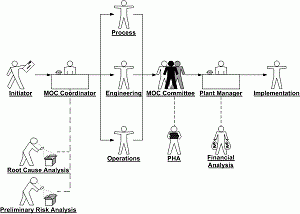Management of Change

Price
Add to Cart
Overview
The proper management of change (MOC) lies at the heart of any successful risk management or process safety management program. It can be taken for granted that everyone associated with the design and operation of any industrial facility wants to do a good job. Yet, in spite of their best intentions, accidents continue to happen; people get hurt, production is lost, and the environment is polluted. All of these undesired events are caused by uncontrolled change. Someone, somewhere moved operating conditions outside their safe range without taking the proper precautions, i.e., without implementing the MOC process.
Simply setting up an MOC system, with its accompanying forms and software, is not sufficient. The people who use the system must understand its intent and the manner in which it is to be used. A facility’s MOC program may look good on paper, but, if the people working there do not understand its fundamental purpose then that program will not be effective. MOC is not just a program — it is a way of life for all employees and contract workers.
There is, however, one note of caution that should be sounded. It has been stressed throughout this book that a key to a successful process safety program is to develop a culture that encourages the involvement of all employees. In this respect, an MOC program is different. The program imposes a clear structure and discipline on all employees and discourages spontaneous actions.
The effort needed to properly manage change can be substantial. It has been reported (Bradley, 1996) that the number of changes that flow through the MOC system is typically around 250 per year for a medium-sized site (with say 140 employees) and up to 1,000 a year for a large site with say 2,000 employees. One world-scale refinery in Texas had 1,400 changes in 2008. About 75% of the changes were regarded as moderate, i.e., they were not perceived as materially affecting the safety of the unit; nevertheless, they had to be handled through the MOC system.
Related Materials
Further discussion and guidance to do with the important topic of Management of Change is provided in 52 Process Safety Moments.
Table of Contents
Introduction
Benefits of Management of Change
Increased Production, Productivity and Quality
Maintenance Expense and Safety
Environmental Performance
Personal Reputation
Definition of MOC
Deviation beyond Limits
Impact on other Process Safety Elements
Critical Changes
In-Kind / Not-In-Kind Change
Same Specification
Same Service and Materials of Construction
Same Storage and Handling Process
Procedural Replacement
Process Chemistry
Instrumentation and Control Systems
Types of Change
Initiated Equipment Change
Large and Small Changes
Turnarounds
Field Change
Non-Initiated Equipment Change
Overt Change
Covert Change
Temporary Changes
Emergency Changes
Administrative and Organizational Change
Reorganization
Management by Contractors
Informal Aspects of MOC
The Management of Change Process
Section A — Initiator Request
Initiator
Personal Recognition
Company Loyalty
Safety
Sponsor
Request Process
Step 1 — Problem / Opportunity Identified
Step 2 — Need For Change
Step 3 — Corrective Action
Step 4 — System Change
Management of Change Form — Section A
Name of the Sponsor / Initiator(s) / Date
Description of Problem and Its Consequences
Proposed Change
Justification
Emergency Change / Temporary Change
Previous Actions Taken
Section B — First Review
In-Kind / Not-In-Kind Change
Selecting the First Reviewers
Management of Change Form — Section B
Name / Date
Discussion
Suggested Modifications
Section C — Detailed Evaluation
Review Process
MOC Coordinator
Review Team
Process Manager
Engineering Manager
Operations Manager
Builders
Project Team
Software
Reviewers
1. Confirm the Problem
2. Problem Analysis
3. Identify Possible Solutions
Qualifications
Experience
Technical Knowledge
Feasibility
“Out-of-the-Box” Thinking
Recommendations
Management of Change Form — Section C
Section D — Formal Approval
Management of Change Committee
Operations
Maintenance
Technical
Engineering/Construction
Process Hazards Analysis
Variance Procedures
Section E — New Limits / Process Safety Update
Section F — Notification
Section G — Implementation
Section H — Follow-Up
